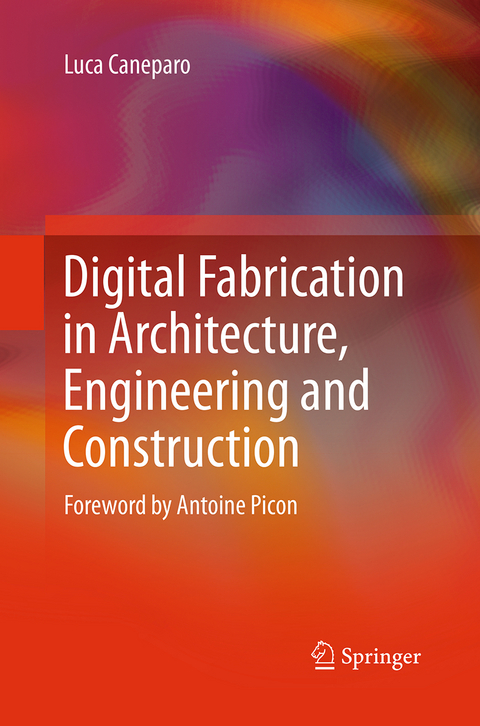
Digital Fabrication in Architecture, Engineering and Construction
Seiten
2016
|
Softcover reprint of the original 1st ed. 2014
Springer (Verlag)
978-94-017-7993-7 (ISBN)
Springer (Verlag)
978-94-017-7993-7 (ISBN)
By collecting information on significant projects and analyzing them, this book explores the technical and artistic potential of digital technology in engineering and architecture.
Digital technologies are changing the relationship between design and construction: with computer models, CAD/CAM, and prototyping, designers can gain direct control of building and construction processes. The ability to digitally model designs, and thus to use those models directly in the context of production, creates a synthesis between design and construction in keeping with the tradition of the close relationship between design and craftsmanship, between the quality of the design and the rules of the craft.
The evolution of the culture of design and construction is the underlying theme of this book. The aim is to discuss the direction that innovation is now taking, with a particular focus on today’s cutting-edge architectures. The method addresses the ways in which different societies have dealt with the issues of their age regarding design and construction, the different contributions provided by various techniques, and with them the meanings expressed by the architecture.
As building design using digital tools requires specific skills in the fabrication processes and in the languages used by information technology, the book also offers a practical guide to new methods and techniques of managing and controlling fabrication for AEC. A systematic analysis of new skills used in the design process presents an overview of opportunities for architects and engineers.
By collecting information on significant projects and analyzing them, the book explores the technical and artistic potential of digital technology. The cases studied are the outcomes of groundbreaking projects which were able to give form and significance to technological research. They show that digital tools are not the exclusive prerogative of large firms but can also beadopted by teams working across small and medium-sized firms – firms which have been able to use informed research to link innovative design with the possibilities offered by digital fabrication in architecture.
Digital technologies are changing the relationship between design and construction: with computer models, CAD/CAM, and prototyping, designers can gain direct control of building and construction processes. The ability to digitally model designs, and thus to use those models directly in the context of production, creates a synthesis between design and construction in keeping with the tradition of the close relationship between design and craftsmanship, between the quality of the design and the rules of the craft.
The evolution of the culture of design and construction is the underlying theme of this book. The aim is to discuss the direction that innovation is now taking, with a particular focus on today’s cutting-edge architectures. The method addresses the ways in which different societies have dealt with the issues of their age regarding design and construction, the different contributions provided by various techniques, and with them the meanings expressed by the architecture.
As building design using digital tools requires specific skills in the fabrication processes and in the languages used by information technology, the book also offers a practical guide to new methods and techniques of managing and controlling fabrication for AEC. A systematic analysis of new skills used in the design process presents an overview of opportunities for architects and engineers.
By collecting information on significant projects and analyzing them, the book explores the technical and artistic potential of digital technology. The cases studied are the outcomes of groundbreaking projects which were able to give form and significance to technological research. They show that digital tools are not the exclusive prerogative of large firms but can also beadopted by teams working across small and medium-sized firms – firms which have been able to use informed research to link innovative design with the possibilities offered by digital fabrication in architecture.
1 Origins of industrial production and prefabrication.- 2 Digital production.- 3 Design for manufacture.- 4 Digital manufacture of metals.- 5 Digital woodworking.
| Erscheinungsdatum | 10.09.2016 |
|---|---|
| Zusatzinfo | 124 Illustrations, color; 41 Illustrations, black and white; XIII, 218 p. 165 illus., 124 illus. in color. |
| Verlagsort | Dordrecht |
| Sprache | englisch |
| Maße | 155 x 235 mm |
| Themenwelt | Kunst / Musik / Theater ► Design / Innenarchitektur / Mode |
| Kunst / Musik / Theater ► Kunstgeschichte / Kunststile | |
| Informatik ► Grafik / Design ► Digitale Bildverarbeitung | |
| Mathematik / Informatik ► Informatik ► Theorie / Studium | |
| Technik ► Bauwesen | |
| Schlagworte | Civil Engineering • digital fabrication • digital manufacturing |
| ISBN-10 | 94-017-7993-7 / 9401779937 |
| ISBN-13 | 978-94-017-7993-7 / 9789401779937 |
| Zustand | Neuware |
| Haben Sie eine Frage zum Produkt? |
Mehr entdecken
aus dem Bereich
aus dem Bereich
Modelle für 3D-Druck und CNC entwerfen
Buch | Softcover (2022)
dpunkt (Verlag)
CHF 48,85
alles zum Drucken, Scannen, Modellieren
Buch | Softcover (2024)
Markt + Technik Verlag
CHF 34,90


